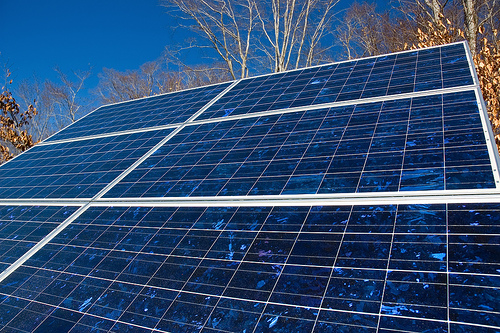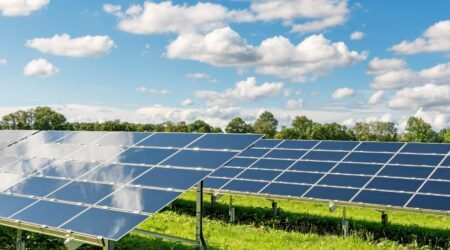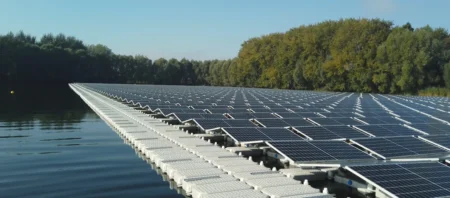Dividing the global yearly demand by 400 kW•h per square meter and we arrive at 496,805 square kilometers (191,817 square miles) as the area required to power the world with solar panels
According to the US Department of Energy (Energy Information Administration), the world consumption of energy in all of its forms (barrels of petroleum, cubic meters of natural gas, watts of hydro power, etc.) is projected to reach 678 quadrillion Btu (or 7.15 exajoules) by 2030 – a 44% increase over 2008 levels (levels for 1980 were 283 quadrillion Btu and we stand at around 500 quadrillion Btu today).
I wonder what surface area would be required and what type of infrastructural investment would be required to supply that amount of power by using only solar panels. To create fuel that can be used in vehicles and equipment I am assuming that some of the electricity generated would be used to create hydrogen. We should all start wondering about these things since we will have really no other choice* by the turn of the next century.
So to find this out we start with the big number 678,000,000,000,000,000 Btu.
Converting this to KW•h [1 Btu = .0002931 kW•h (kilowatt hours)] makes 198,721,800,000,000 kW•h (199,721 TW•h). This is for an entire year. As a comparison, the average household uses approximately 18,000 kW•h per year (1/11 billion of the total world usage).
We can figure a capacity of .2KW per SM of land (an efficiency of 20% of the 1000 watts that strikes the surface in each SM of land).
So now we know the capacity of each square meter and what our goal is. We have our capacity in KW so in order to figure out how much area we’ll need, we have to multiply it by the number of hours that we can expect each of those square meters of photovoltaic panel to be outputting the .2KW capacity (kilowatts x hours = kW•h).
Using 70% as the average sunshine days per year (large parts of the world like upper Africa and the Arabian peninsula see 90-95% – so this number is more than fair), we can say that there will be 250 sun days per year at 8 hours of daylight on average. That’s 2,000 hours per year of direct sunlight.
Therefore, we can multiply each square meter by 2,000 to arrive at a yearly kW•h capacity per square meter of 400 kW•h.
Dividing the global yearly demand by 400 kW•h per square meter (198,721,800,000,000 / 400) and we arrive at 496,804,500,000 square meters or 496,805 square kilometers (191,817 square miles) as the area required to power the world with solar panels. This is roughly equal to the area of Spain. At first that sounds like a lot and it is. But we should put this in perspective.
If divided into 5,000 super-site installations around the world (average of 25 per country), it would measure less than 10km a side for each. The UAE has plans to construct 1,500MW of capacity by 2020 which will require a space of 3 km per side. If the UAE constructed the other 7 km per side of that area, it would be able to power itself as a nation completely with solar energy. The USA would require a much larger area and approximately 1,000 of these super-sites.
According to the United Nations 170,000 square kilometers of forest is destroyed each year. If we constructed solar farms at the same rate, we would be finished in 3 years.
There are 1.2 million square kilometers of farmland in China. This is 2 1/2 times the area of solar farm required to power the world in 2030.
Compare it to the Saharan Desert:
The Saharan Desert is 9,064,958 square kilometers, or 18 times the total required area to fuel the world.
By another measure, “the unpopulated area of the Sahara desert is over 9 million km², which if covered with solar panels would provide 630 terawatts total power. The Earth’s current energy consumption rate is around 13.5 TW at any given moment (including oil, gas, coal, nuclear, and hydroelectric).” This measure arrives at a multiplier of 46 times the area needed and shows that my numbers are very conservative.
Compare it to highways:
At a density ratio of 800km per 1000 square kilometers and a total length of 75,440km, the overall area of the US interstate highway system (constructed entirely between 1956 and 1991 – 35 years) is 94,000 square kilometers, or 20% of the overall required area for the world. The US also consumes about 20% of the world’s energy. (if the efficiency of conversion from solar to electricity was 100%, the area of USA highway would be equal to exactly that required to run the world). Indeed if every nation were to embark on a state program of the scale of the US highway system we could be finished with the required infrastructure in 20-40 years.
Compare it to golf courses:
The typical golf course covers about a square kilometer. We have 40,000 of them around the world being meticulously maintained. If the same could be said for solar farms we would be almost 10% of the way there.
Also remember that we are working here with a worst case scenario based on projections for the year 2030 that assume a lot about growth. What could we do to lower the overall Btu load? And what other sources of clean energy could contribute to lower the area needed for solar panels?
Wave:
World wave energy potential = 2,100,000,000,000 KW•h (2,100 TW•h) or 1% of the required load.
Wind:
A 5 MW turbine can be expected to produce 17 GWh per year (they are 40% effective from their peak rated capacity – 5 MW x 365 x 24 = 43.8 GWh). Therefore, it would require 11,748,294 of the 5 MW capacity turbines to create the same yearly output. There are 500 million cars in the world so it’s not like that’s an unattainable goal from a manufacturing standpoint. And each 5 MW turbine is a 30 year lifespan money making machine for whoever buys it. The same can not be said for my car. But if we can build 90,000 Cape Wind size installations, we would be there on wind alone. Based on that installation, each turbine requires 1/2 square mile of area for offshore sites. This would require 5.85 million square kilometers for 2030 world energy needs.
Here is a graphic for wind based on the notes above. The area in the North Sea is taken directly from the OMA proposal by Rem Koolhaas the pdf of which can be seen here: www.bdonline.co.uk/Journals/Builder_Group/Building_Design/09_January_2009/attachments/oma.pdf
Existing Hydroelectric:
I say existing hydroelectric because it would be damaging to the environment to construct more dams on rivers. Such designs have been shown conclusively to have a deleterious effects on the ecosystems of the watersheds that are fed by the existing river.
As of 2004, hydroelectric power accounted for 6% of the energy production in the world. A conversion of this percentage into energy capacity makes 28 quadrillion Btu (492 quadrillion Btu x 6%). As a percentage of 2030 levels and accounting, this would be more like 4% and accounting for a hopeful decommissioning of existing dams, let’s assume 2%.
So these other sources together have the potential to reduce the area required by 5% – 25% based on the amount of wind power we tap into. Solar panels are really going to have to do the vast majority of the work but a sustainable solution is going to require a great mix of solutions that are diversified as much as possible.
The technologies are improving and the efficiencies are getting greater. We must make it our goal to by the end of this century construct the area required by at the same time reducing our demand and by starting the necessary infrastructure projects today everywhere around the world. Otherwise the consequences are unthinkable.
*As for nuclear power, it currently produces 2.5% of the world’s energy or 10 quadrillion Btu per year. In 2008, the International Atomic Energy Agency (IAEA) predicted that nuclear power capacity could double by 2030, though that would not be enough to increase nuclear’s share of electricity generation. As for the non-renewable resource of uranium, according to the nuclear industry’s own estimation:
Current usage is about 65,000 tU/yr. Thus the world’s present measured resources of uranium (5.5 Mt) in the cost category somewhat below present spot prices and used only in conventional reactors, are enough to last for over 80 years.
80 years does not equal sustainable. And this is only assuming current use rates (the 5% of world energy needs).
An average plant puts out 3 cubic meters of spent fuel each year. Assuming 1000 plants operating around the world (there are 500 today), that would makes 3,000 cubic meters per year. Over those 80 years this would create a volume of 240,000 cubic meters or a cube of 60 meters on each side (bigger than the Pantheon and roughly equivalent to the volume of the Gol Gumbaz Mausoleum. What do we do with that amount of dangerous radioactive material that has a half life of 2 million years?
www.landartgenerator.org/blagi/archives/127
Share your industry press now!
Are you a PR agency or sustainability-focused organization? Join the World of Renewables network FREE today and gain exclusive access to our platform to promote your business, share the latest industry news, and connect with a global audience of 700,000+ renewable energy professionals.
Register Now to start posting your updates and showcase your expertise to a highly engaged, environmentally-conscious community.
Find out more about our Content Partnership Programs.*2024 AWARD WINNER* Websites & Mobile Sites, Webby Winner, Peoples Voice 2024
















